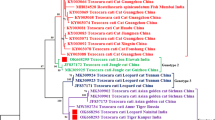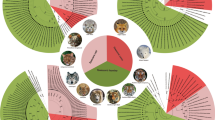Abstract
Toxocara canis and Toxocara vitulorum are two important parasites of dogs and buffaloes with public health concern. The objectives of the present study are to identify molecular markers to discriminate these closely related parasites and to determine their phylogenetic position and genetic diversity within the genus Toxocara. Thus, two mitochondrial genes (complete ATPase 6 and partial small subunit ribosomal RNA (12S rDNA)), two nuclear ribosomal genes (second internal transcribed spacer region (ITS-2)), and part of the large subunit 28S region were analyzed. Nucleotide sequence (597 bp) and predicted amino acid sequences of the complete ATPase 6 gene (199 amino acids) of both species (T. canis and T. vitulorum) are similar in size with the Toxocara cati and Toxocara malaysiensis. There was 88% nucleotide similarity between T. canis and T. vitulorum and many transversions present in the 12S gene. Analyses of the ITS-2 and 28S regions revealed that the 28S region was more conserved (95% nucleotide similarity between T. canis and T. vitulorum) than the ITS-2 region (85%). This study has provided useful molecular markers for the molecular epidemiological investigation of Toxocara species. Further, phylogenetic analyses of the ITS-2 and 28S genes have indicated that the members of the genus Toxocara form a distinct group with reference to their definitive hosts.




Similar content being viewed by others
References
Bowles J, Blair D, McManus DP (1995) A molecular phylogeny of the human schistosomes. Mol Phyl Evol 4:103–109
Casiraghi M, Anderson TJC, Bandi C, Bazzocchi C, Genchi CA (2001) Phylogenetic analysis of filarial nematodes: comparison with the phylogeny of Wolbachia endosymbionts. Parasitol 122:93–103
Gibbons LM, Jacobs DE, Sani RA (2001) Toxocara malaysiensis n. sp. (Nematoda: Ascaridoidea) from the domestic cat (Felis catus Linnaeus, 1758). J Parasitol 87:660–665
Glickman LT, Magnawal JF (1993) Zoonotic roundworm infections. Infect Dis Clin North Am 7:717–732
Gupta GC, Josul BP, Rai P (1976) Some aspects of biochemical studies in calf disease ascariasis and scour. Indian Vet J 53:438–441
Habluetzel A, Traldi G, Ruggieri S, Attili AR, Scuppa P, Marchetti R (2003) An estimation of Toxocara canis prevalence in dogs, environmental egg contamination and risk of human infection in the Marche region of Italy. Vet Parasitol 113:243–252
Kazacos KR (2000) Protecting children from helminthic zoonosis. Contemp Pediatr 17:1–24
Li MW, Zhu XQ, Gasser RB, Lin RQ, Sani RA, Lun ZR (2006) The occurrence of Toxocara malaysiensis in cats in China, confirmed by sequence-based analyses of ribosomal DNA. Parasitol Res 99:554–557
Littlewood DT, Johnston DA (1995) Molecular phylogenetics of the four Schistosoma species groups determined with partial 28S ribosomal RNA gene sequences. Parasitol 111:167–175
Mia S, Dewan ML, Uddin M, Chowdhury MVA (1975) The route of infection of buffalo calves by Toxocara (Neoascaris) vitulorum. Trop Ani Health Prod 7:153–156
Minnaar WN, Krecek RC, Fourie LJ (2002) Helminths in dogs from a peri-urban resource limited community in Free State Province, South Africa. Vet Parasitol 107:343–349
Nadler SA, Hudspeth DSS (1998) Ribosomal DNA and phylogeny of the Ascaridoidea (Nemata: Secernentea) Implications for morphological evolution and classification. Mol Phyl Evol 10:221–236
Oliveira-Sequeira TC, Amarante AF, Ferrari TB, Nunes LC (2002) Prevalence of intestinal parasites in dogs from Sao Paulo State, Brazil. Vet Parasitol 103:19–27
Patnaik MM, Pande BP (1963) Notes on the helmintic infestations encountered in one-month-old buffalo calves. Indian Vet J 40:128–133
Roberts JA, Fernando ST, Sivanathan S (1990) Toxocara vitulorum in the milk of buffalo (Bubalus bubalis) cows. Res Vet Sci 49:289–291
Starke WA, Machado RZ, Honer MR, Zocoller MC (1983) Natural course of gastrointestinal helminthic infections in buffaloes in Andradina County (SP). Arq Bras Med Vet Zoo 35:651–664
Starke WA, Machado RZ, Zocoller MC (1992) Transmammary passage of gastrointestinal nematode larvae to buffalo calves. II. Toxocara vitulorum larvae. Arq Bras Med Vet Zoo 44:97–103
Umehara F, Ookatsu H, Hayasi D, Uchida A, Douchi Y, Kawabata H, Goto R, Hashiguchi A, Matsuura E, Okubo R, Higuchi I, Arimura K, Nawa Y, Osame M (2006) MRI studies of spinal visceral larva migrans syndrome. J Neuro Sci 249:7–12
Urqhuart GM, Armour J, Duncan JL, Dunn AM, Jennings FW (1996) Veterinary parasitology, 2nd edn. Oxford, Blackwell
Xie X, Bain O, Williams SA (1994) Molecular phylogenetic studies on filarial parasites based on 5S ribosomal spacer sequences. Parasite 1:141–151
Yatawara L, Wickramasinghe S, Nagataki M, Rajapakse RPVJ, Agatsuma T (2007) Molecular characterization and phylogenetic analysis of Setaria digitata of Sri Lanka based on CO1 and 12S rDNA genes. Vet Parasitol 148:161–165
Acknowledgment
We extend our thanks to Prof. David Blair of James Cook University, Australia for invaluable review of the manuscript.
Author information
Authors and Affiliations
Corresponding author
Rights and permissions
About this article
Cite this article
Wickramasinghe, S., Yatawara, L., Rajapakse, R.P.V.J. et al. Toxocara canis and Toxocara vitulorum: molecular characterization, discrimination, and phylogenetic analysis based on mitochondrial (ATP synthase subunit 6 and 12S) and nuclear ribosomal (ITS-2 and 28S) genes. Parasitol Res 104, 1425–1430 (2009). https://doi.org/10.1007/s00436-009-1345-9
Received:
Accepted:
Published:
Issue Date:
DOI: https://doi.org/10.1007/s00436-009-1345-9




